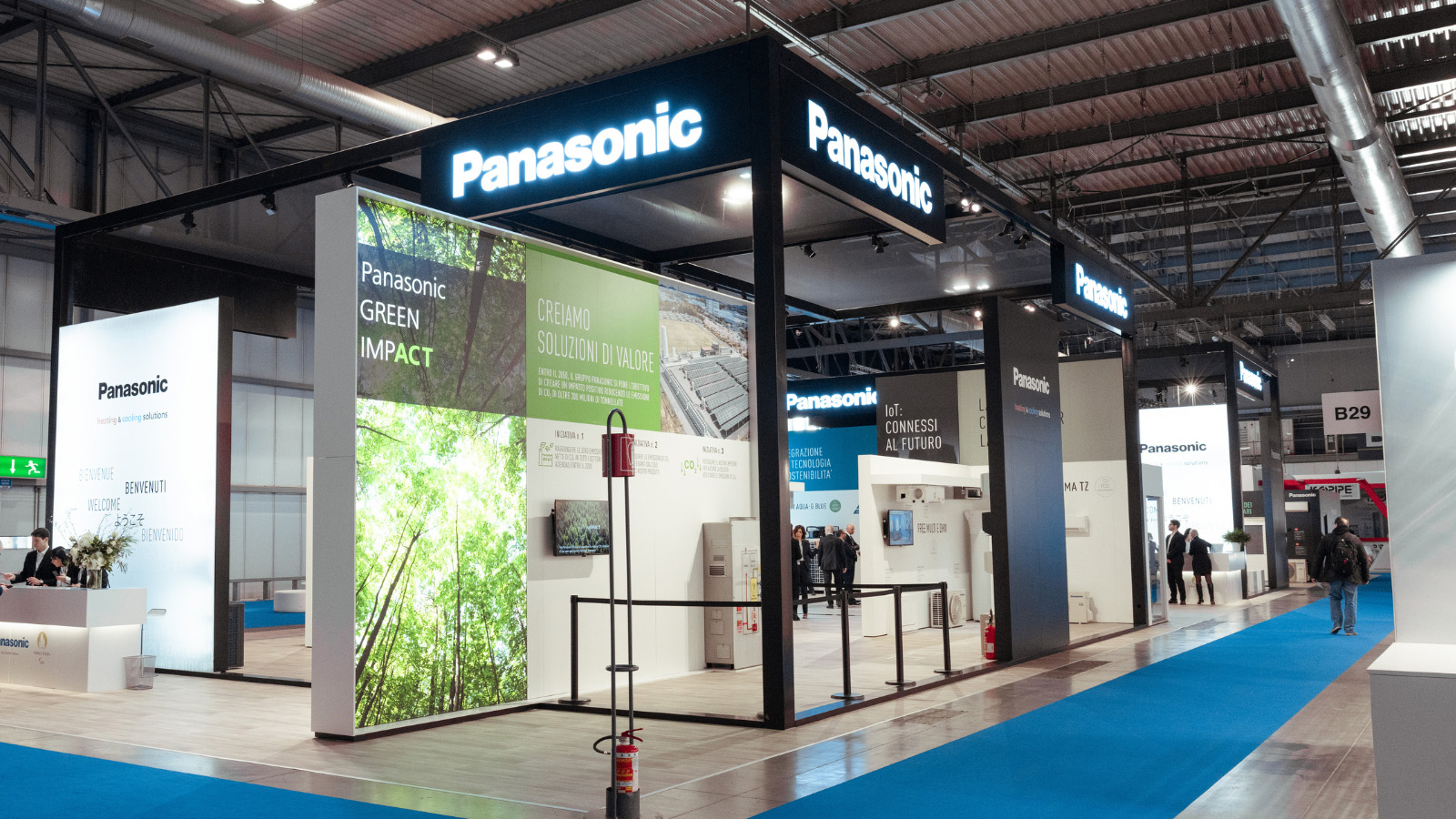Oct 07, 2008
Press Release
Panasonic Achieves Production of 300 Million TV Sets, a World's Record
Osaka, Japan - Panasonic Corporation announced today it is set to roll out its 300 millionth TV set on October 7, 2008, which marks the 56th year since the company began producing them in 1952. This makes Panasonic the world's first TV manufacturer to reach this level of production.
After recording a cumulative production of 100 million sets in 1985, the company began applying in 1988 the Panasonic brand name to all the TVs that it sold in Japan.*1 In 1998, cumulative production of television sets reached the 200-million mark.
On October 1, 2008, the corporate name was changed to Panasonic Corporation, and brand names were unified to Panasonic. In this commemorative year, the company has reached a milestone in its corporate history by achieving production of the 300 million sets. In fact, the company produced 105 million National brand TVs and 195 million Panasonic brand TVs, bringing visual entertainment to people all over the world.
*1 Panasonic TV market launches: U.S. in 1961, Europe in 1979, and Japan in 1988.
<Leading Up to the 300-Million Mark>
Panasonic began producing black-and-white TVs in November 1952, one year before full-scale TV broadcasting began in Japan. In 1960, the company became the first manufacturer of color TVs in Japan.
A stream of popular TV units have been produced since then. They include the "Saga Series" of black-and-white TVs (1965), based on the design concept of "TV as furniture"; the "Quintrix" color TVs (1974), which gained popularity with a number of eye-catching TV commercials on air, contributed to boosting popular acceptance of color TVs with the built-in energy-saving circuitry; the "α2000X Series" (1985), having incorporated the then most advanced technologies, was introduced to commemorate the company's cumulative production of the 100 millionth TV set; the "Gaoo Series" (1990) achieved unprecedented sales of 4 million units; and the T (tau) flat-screen digital CRT TVs (1998) came out.
In 2003, VIERA flat-panel digital TVs were released to coincide with the launching of terrestrial digital broadcasting in Japan, and raised the curtain on a whole new era for TVs. Since then, VIERA TVs have been leading Panasonic's TV production and sales in line with the global progress of digital broadcasting. On October 7, 2008, the newest VIERA model, the TH-50PZR900 (available in Japan on September 10), marks the cumulative production of the 300 millionth TV.
<Moving Next Toward 400 Million Units>
TVs used to be the leading source of entertainment for every family member. In order to realize the new "digital hearth," serving as the center of the home where the family and friends gather, Panasonic is maximizing its leading-edge technologies to develop ultra-large screens and super-thin display panels. It will also improve its wireless technologies to make the best of the new flat-panel TVs. Above all, the company is committed to creating high-efficiency technologies that can attain not only high-quality images and high technical performance but also contribute significantly to environmental protection.
Panasonic is grateful for the support of its customers who have made it possible for the company to achieve a cumulative production of 300 million TV sets, and remains committed to its basic management policy of "delivering satisfaction to customers through the most advanced technology." The company actively promotes its TV business with the next goal of achieving a cumulative production of 400 million TVs. Through these efforts, Panasonic will move on to contribute to further advancement of TV culture around the world in order to enrich life for people everywhere.
About Panasonic
Panasonic Corporation is a worldwide leader in the development and manufacture of electronic products for a wide range of consumer, business, and industrial needs. Based in Osaka, Japan, the company recorded consolidated net sales of 9.07 trillion yen (US$90.7 billion) for the year ended March 31, 2008. The company's shares are listed on the Tokyo, Osaka, Nagoya and New York (NYSE Symbol: PC) stock exchanges. For more information on the company and the Panasonic brand, visit the company's website at http://panasonic.net/.
<Reference>
TV Business in Transition
Technological Evolution
The fundamental technologies, which have enabled Panasonic's cumulative production of 300 million TVs, have undergone dramatic transformation in the past. TV circuit components changed from vacuum tubes to transistors, to ICs and then the LSIs. High-density circuit integration created one-chip LSIs that became standard components in digital broadcast receivers and decoders. Further development of this technology led to creation of the original PEAKS*2 technology and the UniPhier*3 platform that enabled VIERA Link. The evolution of LSIs not only improved basic TV performance but also enhanced ease, convenience and safety in operating TV, bringing richer and more comfortable lifestyles to people around the world.
| *2 | One-chip LSI designed exclusively for digital TVs. |
| *3 | General-purpose LSI developed to simplify the connection of digital equipment and devices. |
Meanwhile, the display, which is the "face" of the TV, has made remarkable progress as well, making it possible to replace cathode-ray tubes (CRTs) with large-screen, flat-panel displays such as plasma and LCD displays.
As the advancement of flat-panel display technologies synchronize with the rapid progress of global-scale digital broadcasting, such as digital satellite broadcasting and terrestrial digital broadcasting that started in Japan in 2000, flat-panel TVs using plasma or LCD panels have been quickly replacing CRT TVs, since the newer display panels work better with digital technology. In fiscal 2008, plasma and LCD flat-panel TVs accounted for more than half of the worldwide TV demand.
Panasonic began producing 42-inch plasma TVs in 1997 and 22-inch LCD TVs in 2000, followed by 32-inch LCD TV in 2003. In 2005, the company began manufacturing the world's first 65-inch full HD plasma display. In 2006, the company established mass-production technologies for the world's largest 103-inch full HD plasma display. These are cases which demonstrate Panasonic's endeavors to meet customers' needs for larger screens.
This year, Panasonic developed the revolutionary NeoPDP*4 technology for plasma display panels. Panasonic expects this to become one of it core technologies that will contribute to further evolution of TV technologies.
| *4 | A collective name given to three technical developments announced in January, 2008 -- (1) High efficiency (twice the brightness, half the power consumption), (2) An ultra-large, 150-inch panel, and (3) A super-thin, fully flat panel only 24.7 mm deep. |
Global Development
Panasonic has also been promoting globalization of its TV production. The company began exporting TVs to Thailand in 1956.
In 1963, Panasonic Taiwan Co., Ltd., formerly Matsushita Electric (Taiwan) Co., Ltd., began local TV production. Since then, Panasonic has been running its TV operations by selecting the best location in light of the prevailing situation.
At present, the company focuses on a vertically integrated business strategy for production operations,*5 from the manufacturing of flat-panel displays through the assembly of finished TVs, aimed at further improving its international competitiveness. Panasonic now manufactures all display devices in Japan and operates TV assembly plants at locations worldwide near consumer markets. By establishing a production system that is capable of responding quickly to consumer needs, the company continues to respond promptly to market needs and cost competitiveness.
By facilitating the production of TVs for various broadcasting systems in use around the globe and responding promptly to local service needs, Panasonic's global production system allows to satisfy diverse needs of customers of the world.
*5 Number of TV production facilities: 16 locations around the world (as of October 2008)
History of TV Operations
• Start of TV Business
In 1925, an experiment in transmitting TV signals succeeded for the first time in England. In 1935, Panasonic began basic TV research and development, and the world's first TV broadcasting tests started in Germany in the same year. In 1953, full-fledged TV broadcasting began in Japan. One year earlier, in 1952, Panasonic began producing black-and-white TVs.
• Full-Scale TV Diffusion
In 1958, Panasonic established what was then the nation's most advanced TV manufacturing factory in Ibaraki City, Osaka. In the following year, broadcasting of the Imperial Wedding of the present Emperor and Empress spurred a TV boom. This led TVs into a period of full-scale penetration in the market.
When color broadcasting began in 1960, Panasonic started manufacturing color TVs ahead of the rest of the industry. Color TVs started gaining explosive popularity in 1970, the year that Osaka hosted World Expo in Japan. In 1973, penetration rate of color TVs exceeded that of black-and-white TVs.
• From National to Panasonic
In 1988, the brand name for the company's TVs for the domestic market was unified to Panasonic. As Japan's most recent economic boom started around that time, demand for larger screens as well as added-value features and functions grew, bringing a new phase of development to TVs, which were previously considered an already matured industry. In 1990, in pursuit of the ultimate TV set in those days, the Gaoo Series was launched by making the best of resources available at the company as a whole. The company introduced the first high-definition TV as NHK started testing analog HD broadcasting in 1991. Eventually, TV screen aspect ratio shifted from 4:3 to 16:9.
• On to a New Age of TV Entertainment
As the 21st century began, digital broadcasting has been making progress and TV tuners went through transition from analog to digital. This has also accelerated the shift to large-screen and flat-panel TVs, marking another stage of TV development.
Besides receiving TV signals, TVs have gained other capabilities by being linked with peripheral devices and other products. As the information centers at home for the new era, TVs are now required to provide even more and newer functions.
Panasonic continues to develop new technologies for its next-generation TVs in an effort to deliver a greater fun and comfort that will enrich life and society.
Media Contacts:
- Akira Kadota, International PR
- Panasonic Corporation
- Tel: 03-3578-1237 Fax: 03-3436-6766
- Panasonic News Bureau
- Tel: 03-3542-6205 Fax: 03-3542-9018
Banner area begins from here.
The content in this website is accurate at the time of publication but may be subject to change without notice.
Please note therefore that these documents may not always contain the most up-to-date information.
Please note that German, French and Chinese versions are machine translations, so the quality and accuracy may vary.






